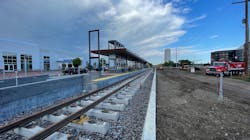First rail installed for Southwest LRT project
Contractors installed the first rail of the Southwest Light Rail Transit (LRT) Project that will extend Metro Transit’s Green Line 14.5 miles between downtown Minneapolis to St. Louis Park, Hopkins, Minnetonka and Eden Prairie.
The rail was installed Aug. 11 near the future Downtown Hopkins Station; one of 16 new stations being constructed along the extension.
“Moments like these affirm my belief in transit and the communities it serves,” said Metropolitan Council Chair Charlie Zelle. “Southwest LRT will positively change lives by providing easier access to housing, education and healthcare.
“These first several feet of LRT track represent something bigger than just a light rail line,” he continued. “They represent our communities, our region and our state coming together and committing to improve the lives of neighbors and ourselves. I am immensely proud of this project and the people who have made it happen.”
Employment within half a mile of the line’s stations is expected to grow to 80,900 by 2035 and by 18 percent – 145,300 – in downtown Minneapolis by the same year. The Metropolitan Council estimates the population within half a mile of the stations will grow by 56 percent by 2035 and the population of downtown Minneapolis is expected to grow by 117 percent.
“This first set of light-rail tracks points towards our shared vision for the future and our commitment to supporting equitable growth,” said Marion Greene, chair of the Hennepin County Board of Commissioners. “As we confront the climate crisis and work to reduce racial disparities, this project is putting our region quite literally on track for long-term success. It will reduce our reliance on cars, offer accessible multimodal transportation choices and drive inclusive development and investment that will benefit all residents. Today, we’re closer than ever to realizing the lasting benefits of Southwest Light Rail and I’m excited by the progress being made.”
The $2-billion project, which broke ground in December 2018, is more than 50 percent complete with 11 of the 16 stations under construction or nearly complete. The project secured a $928.8 million Full Funding Grant Agreement with the Federal Transit Administration through the Capital Investment Grants Program in September 2020. The rest of the funding is a mix of state and local funding with Hennepin County contributing more than $591 million to the project.
The project timeline on Metropolitan Council’s website still targets the start of passenger service for 2023. However, earlier this year, Metropolitan Council and Hennepin County said the project could be delayed due to unforeseen conditions experienced during the 2020 construction season.
Southwest LRT is the largest public infrastructure project in Minnesota’s history and its light-rail, freight and regional trail components contribute to its complexity. The project is expected to be transformational to the community with Metropolitan Council reporting there has already been more than $1.5 billion of investment within a half-mile of the line.
“Our LRT lines serve as a backbone for the entire Metro Transit system,” said Metro Transit General Manager Wes Kooistra. “Our job is to get our customers where they need to go in a timely and efficient manner and Southwest LRT will be integral to our system moving forward.”
About the Author

Mischa Wanek-Libman
Group Editorial Director
Mischa Wanek-Libman is director of communications with Transdev North America. She has more than 20 years of experience working in the transportation industry covering construction projects, engineering challenges, transit and rail operations and best practices.
Wanek-Libman has held top editorial positions at freight rail and public transportation business-to-business publications including as editor-in-chief and editorial director of Mass Transit from 2018-2024. She has been recognized for editorial excellence through her individual work, as well as for collaborative content.
She is an active member of the American Public Transportation Association's Marketing and Communications Committee and served 14 years as a Board Observer on the National Railroad Construction and Maintenance Association (NRC) Board of Directors.
She is a graduate of Drake University in Des Moines, Iowa, where she earned a Bachelor of Arts degree in Journalism and Mass Communication.
